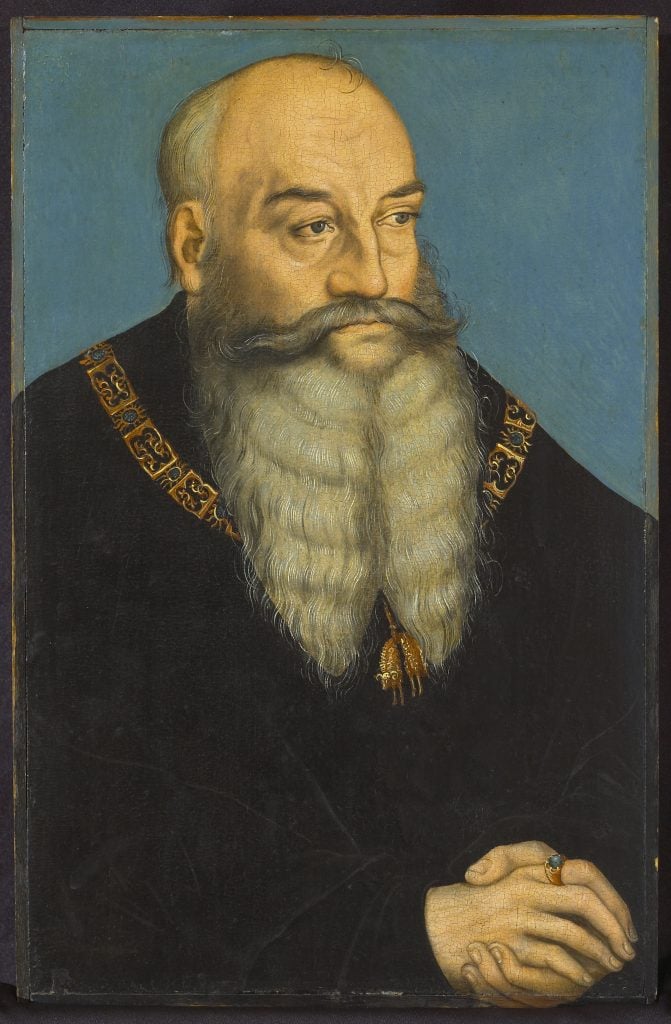Museums & Institutions
Cranach Painting, Sold Under Duress During WWII, Now Bound for Auction
Allentown Art Museum is selling the painting and will split the proceeds with the heirs of the work's one-time Jewish owners.

Allentown Art Museum is selling the painting and will split the proceeds with the heirs of the work's one-time Jewish owners.

Richard Whiddington

When the German Jewish couple, Henry and Hertha Bromberg, fled the Nazis in 1938, they had no choice but to dispense with their fine art collection. Reaching safety was the imperative and they used the sales to fund their passage to France, Switzerland, and ultimately the United States.
Over the past decade, the couple’s descendants have sought to confront the injustice through approaching institutions in possession of Bromberg art. The most recent agreement will see Allentown Art Museum in Pennsylvania deaccession Portrait of George the Bearded, Duke of Saxony, by Lucas Cranach the Elder and his workshop, at Christie’s Old Masters sale, which is set to take place in New York in January.
Created by the northern Renaissance court painter around 1534, it depicts a pensive Duke of Saxony wearing a dark robe and his Order of the Golden Fleece chain. A masterful example of Cranach’s mannered portraits of Saxon royalty, the proceeds of the sale will be split between the museum and the Bromberg heirs.
This decision, as opposed to a full restitution, was described by the museum as striking a balance between its fiduciary duties and its commitment to upholding the highest ethical stewardship standards.
After receiving the claim by Bromberg’s heirs in July 2022, the museum conducted research on the painting’s provenance alongside an outside counsel with expertise in art restitution. While both parties agree the Cranach was sold under duress as the Bromberg’s fled Nazi Germany, they disagree on timing. Bromberg’s descendants believe the painting was sold before the couple left Germany and the museum’s research suggests it happened later.
“The historical record indicates that the painting was not confiscated by the Nazi regime nor the subject of a forced sale,” the museum’s president Max Weintraub said via email. “Rather, the painting is likely best considered part of an emerging concept known as ‘Flight Goods’: property sold in transit while fleeing from persecution.”

Henrietta Schubert, Audrey Azoulay, and and Christopher Bromberg during the restitution of the painting Portrait d’homme by Joos Van Cleve, in Paris on November 28, 2016. Photo courtesy Francois Guillot/AFP/Getty Images.
According to the museum, the painting was sold by the Brombergs to the F. Kleinberger Gallery in Paris before being acquired by the Pennsylvania institution through a New York gallery in 1961. Weintraub called the settlement an “amicable resolution.”
Christie’s, which did not respond to a request for comment, is yet to set a pre-auction valuation of the painting. The highest price achieved for a painting listed as Lucas Cranach the Elder and his workshop was “Saint Jerome in Penance,” which sold for $1.1 million at Lucerne’s Galerie Fischer Auktionen. At Christie’s Old Masters sale last year, a portrait by the artist of Henry IV, Duke of Saxony, sold for $352,800.
The Bromberg’s descendants are still in pursuit of roughly 80 works lost during the flight from Nazi Germany. In 2016, a painting attributed to the 16th-century artist Joos van Cleve was returned by the French Culture Ministry. The Ministry followed up in 2018 by three paintings by the 16th-century Flemish artist Joachim Patinir.